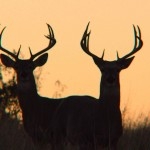
Density

Density is defined as “the amount of something per unit of measure”. The density of cattle and deer on a property are the primary factors influencing the overall production of the ranch. It is a balancing act to match the animals with the ever-changing food supply of the property. A progressive manager must react in an efficient manner if continued success is to be realized during the good and bad habitat times.
Cattle numbers are obviously much easier to manage than deer. In a wildlife-oriented operation, cattle should be stocked conservatively during all weather conditions. As they say, “We are one day closer to the next drought”, so plan for such limitations and stock cattle lightly. Light stocking rates allow for fewer cattle to consume more grass per head and allow them to reach their full genetic potential. As their body condition and score improves, so does their reproductive capacity and performance. Rotate cattle often throughout the property and allow them to remove only half of the available grass, leaving the other half for ground protection and wildlife cover. Proper cattle management directly benefits wildlife production. A healthy habitat today creates healthy animals tomorrow.
Research has proven that approximately 7% of a deer’s total diet is grass. The other 93% is a combination of forbs (weeds), mast (fruits, acorns, berries) and browse (leaves and twigs of brush). Forbs and mast are short-term delicacies available only when timely rains occur, while browse plants support the majority of a deer’s diet throughout the year. Browse plants are not created equally, but are classified according to their preference by deer. The most highly preferred deer browse species are usually those most limited on a property so managing the foraging pressure put on those plants by deer is the astute manager’s primary goal. In a healthy ecosystem, you should not notice an obvious browse line or hedging effect on preferred deer plants. If you do, reduce the total number of mouths on the range…. it is just that basic. Maintaining a deer population within the present food supply is critical for optimum production and remains one of the biggest challenges facing managers today.
Supplemental feeding deer is a common practice throughout Texas and is most beneficial when used correctly. Supplemental feeding is not meant to be used to carry extra deer that the native habitat cannot support, but rather a supplement to the native forage and to provide additional trace minerals and additional protein when the deer require it most. Simply put, carrying too many deer on a ranch results in poor habitat, an escalating feed bill and a decline in antler growth. Supplemental feeding is not a replacement for good management; rather, it is a tool to be used to compliment good management. On average, one deer consumes $0.25 of supplemental feed per day plus the native forage. On overstocked properties with poor habitat, the same deer consume much more feed per head with less favorable results and a higher feed bill.
For deer, selective harvesting is the best method to control numbers. Trapping and removal is another option, but is not practical in most situations. Selective harvest is the act of removing animals in a controlled and managed fashion. Selective harvesting is utilized to maintain the deer numbers within the food supply produced by the habitat at any given time; it can also be used to obtain a desired sex ratio and to achieve a desired age structure. Maintaining deer within the carrying capacity of the habitat will improve fawn production and survival, increase body weight, improve antler development, and prevent habitat deterioration.
Habitat is where the deer live every day, rain or shine. A healthy habitat produces healthy animals. Managing to protect the habitat is critical. Habitat that is overstocked with cattle or deer on a long-term basis will yield a decline in the total carrying capacity, animal nutrition, health and performance. Just because it rains today doesn’t mean you can increase your animal densities tomorrow. It takes time, often months or even years, before the habitat recovers enough to support extra animals. Be mindful of the responding habitat and adjust management actions accordingly.
All photo and content herein is copyrighted property of Spring Creek Outdoors, LLC and may not be copied/reproduced or otherwise used in any way without express written permission from Spring Creek Outdoors, LLC. All rights reserved.
Posted in: Deer Management
